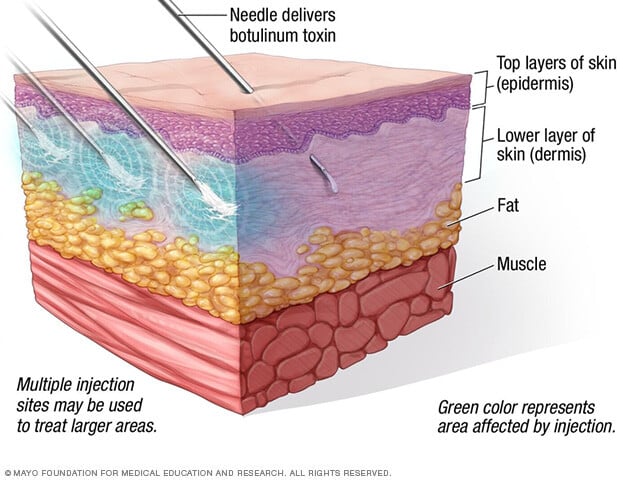Botox injections
Overview
Botox injections are shots that use a toxin to prevent a muscle from moving for a limited time. These shots are often used to smooth wrinkles on the face. They're also used to treat neck spasms, sweating, overactive bladder, lazy eye and other conditions. Botox shots also may help prevent migraine.
The medicine in Botox injections is made from the same toxin that causes a type of food poisoning called botulism. But the forms of purified botulinum toxin used by licensed health care providers meet medical control standards. These standards were approved by the U.S. Food and Drug Administration. As a rule, the bacteria toxins used for medical purposes are not harmful if used correctly.
Why it's done
Botox shots block certain chemical signals from nerves that cause muscles to contract. The most common use of these injections is to relax the facial muscles that cause frown lines and other facial wrinkles.
Botox injections also are used to ease symptoms of some health conditions. It's not a cure. Examples of medical conditions that might be treated with Botox injections include:
- Neck spasms. In this painful condition, the neck muscles contract in an uncontrolled way. This causes the head to twist or turn into an uncomfortable position. The condition also is called cervical dystonia.
- Other muscle spasms. Cerebral palsy and other conditions of the nervous system can cause the limbs to pull in toward the center of the body. Muscle spasms also can cause eye twitching.
- Lazy eye. The most common cause of lazy eye is an imbalance in the muscles used for moving the eye. Lazy eye also is called crossed eyes or misaligned eyes.
- Sweating. Botox might be used for a condition in which people sweat a lot even when they're not hot or working up a sweat. It's called excessive sweating or hyperhidrosis.
- Migraine. Botox injections may help reduce how often you get a migraine. This treatment is used mainly for people who have headaches 15 or more days a month. When you get serious headaches that often, the condition is called chronic migraine. Treatment is needed about every three months to retain the benefit.
- Bladder problems. Botox shots can also help reduce urinary incontinence caused by an overactive bladder.
Risks
Botox injections are usually safe when you're under the care of a licensed and skilled health care provider. The procedure can result in unwanted results or even cause harm if it's given incorrectly. Possible side effects and unwanted results include:
- Pain, swelling or bruising at the injection site.
- Headache or flu-like symptoms.
- Droopy eyelids or crooked eyebrows.
- A crooked smile or drooling.
- Watery or dry eyes.
- Infection at the injection site.
Rarely, the medicine may spread to parts of the body where it isn't supposed to go. It can cause symptoms there. Call your health care provider right away if you have any of these symptoms hours or weeks after your procedure:
- Muscle weakness.
- Vision problems.
- Trouble talking or swallowing.
- Breathing problems.
- Allergic reaction.
- Loss of bladder control.
As a rule, health care providers don't recommend Botox if you're pregnant or breastfeeding.
Select your health care provider carefully
Botox is a prescription medicine and must be used only under the care of a licensed and skilled health care provider. Talk with your health care provider about whether the procedure fits your needs.
To find an expert in Botox injections, ask for a referral from your primary care provider.
How you prepare
Which type of botulinum injection is right for you depends on your needs and condition. Talk with your health care provider about the treatment best suited to you.
Tell your health care provider if you've had any type of Botox injection within the past four months. Also tell your health care provider if you take blood thinners. You may need to stop taking them several days before your injection to reduce the risk of bleeding or bruising. Talk with the health care provider who prescribes these medicines as soon as you can.
What you can expect

Before the procedure
Most people don't feel much pain during the procedure. But you may want your skin numbed beforehand, especially if your palms or feet are being treated for heavy sweating. Your health care provider might use one or more of the following methods to numb the area: anesthetic applied to the skin, ice and massage. The massage method also is called vibration anesthesia.
During the procedure
Botox injections are usually performed in a medical office. Your health care provider uses a thin needle to inject tiny amounts of botulinum toxin into your skin or muscles. The number of shots needed depends on the size of the treatment area and other things. Sometimes ultrasound is used to guide the needle to the right spot.
Botulinum toxin is available in two forms:
- Type A. Type A is mainly used for treating facial wrinkles. Type A products include onabotulinumtoxinA (Botox), abobotulinumtoxinA (Dysport), incobotulinumtoxinA (Xeomin), daxibotulinumtoxinA (Daxxify) and prabotulinumtoxinA (Jeuveau).
- Type B. Type B is often the first choice for treating neck spasms. It's sold as rimabotulinumtoxinB (Myobloc).
After the procedure
Do not rub or massage the treated areas for 24 hours. And don't lie down for 2 to 4 hours after getting the shots. Following this advice helps prevent the toxin from spreading to an area where it isn't needed. You'll likely be able to return to your usual activities right after the procedure — check with your health care provider.
Results
Botox injections usually begin working 1 to 3 days after treatment, though it can take a week or more to see full results. Not all people have visible results or relief from symptoms.
Depending on the problem being treated, the effect may last 3 to 4 months. To maintain the effect, you'll likely need regular follow-up injections spaced at least three months apart.



